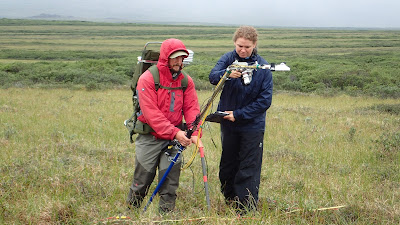Many scientists have reported on the “greening of the Arctic” and speculated that this might be due to increased productivity of existing shrubs, expansion of shrubs in places they already exist, and then the movement or migration of shrubs onto previously shrub-free tundra. A greening of the Arctic has important consequences to the biophysical feedbacks between the land surface and atmosphere.
One of the critical objectives in NGEE Arctic is in knowing more about what controls shrub distribution in tundra ecosystems. Our first step in tackling this challenge lies in characterizing field sites on the Seward Peninsula for shrub abundance and then working to understand how shrub dynamics vary by landscape position and as influenced by soil water content, active layer thickness, etc.
Today, Mark, Peter, and I began measuring shrub abundance along several 800 to 2200 meter transects established earlier in the year at our field site outside Nome. This involved identifying specific points along those transects and measuring the distance to the closest “tall” shrub in each of four quadrants. We focused on several Salix, Betula, and Alnus species. It was a somewhat tedious process of not only measuring the distance to the nearest shrub, but also using digital calipers to measure stem diameters for anywhere from one to several dozen stems per plant. The alders, in particular, and sometimes the larger Salix, were time-consuming to measure since each shrub might consist of up to 18 stems.
Regardless of the difficulty in making these measurements they are important data to collect and central to several of the major questions being addressed by NGEE Arctic. We will couple this information with data on plant traits, soil temperature, and soil moisture. Insights gained will help improve our description of vegetation dynamics, specifically shrubs, in computer models.







































